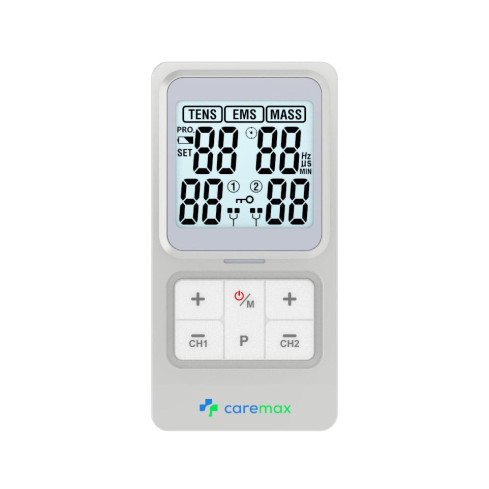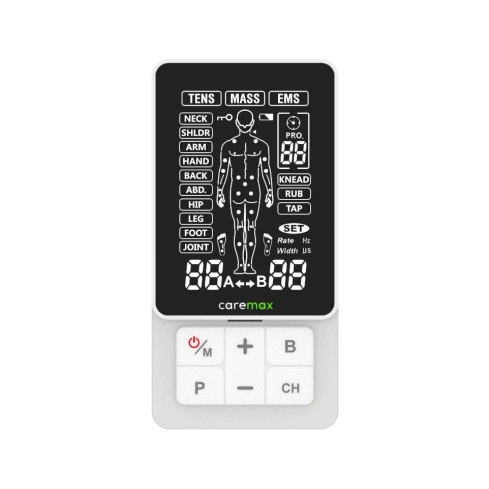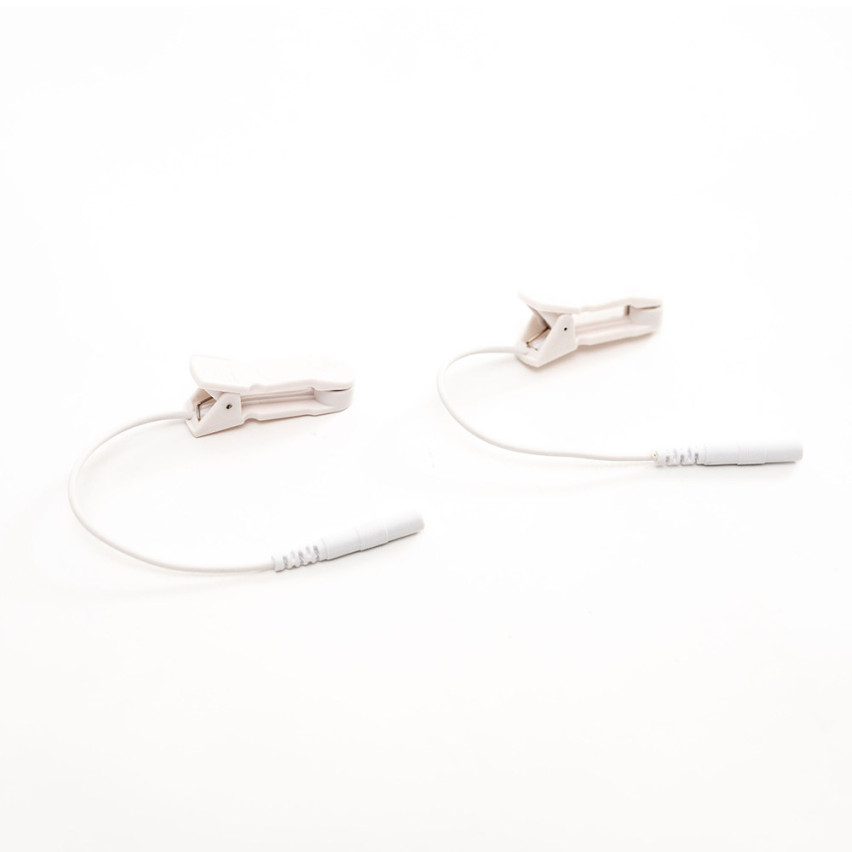Product added to cart
- Home
- TENS & EMS
- Using TENS Machine for Vagus Nerve Stimulation
What is vagus nerve stimulation?
The vagus nerve is one of the twelve cranial nerves that begin from the back of the brain. Each cranial nerve has a unique role in controlling the movement and sensation of the head, face and neck. The vagus nerve is crucial for keeping the body alive by maintaining several key body regions, including:
- Pharynx
- Larynx (also known as the voicebox)
- Throat
- Gastrointestinal tract
- Heart
- Other internal organs (e.g., stomach, pancreas, lungs, etc.)
Vagus nerve stimulation is a treatment that sends electrical impulses to the vagus nerve. These electrical impulses change abnormal brain or nerve activity that may contribute to conditions such as depression, epilepsy and migraines. Health professionals may recommend vagus nerve stimulation as a treatment for these conditions.
Methods of vagus nerve stimulation
There are two common types of vagus nerve stimulation: device implantation or TENS machine. This treatment is comparable to a vagus nerve massage but with electricity instead.
Device implantation requires surgery to place a little machine underneath the skin of the chest, which has wires running to the vagus nerve (around the neck). Electric impulses are delivered from the device through the wires and into the vagus nerve for its effect [2].
TENS machines deliver electrical impulses through the skin without surgery. Special ear clips are placed onto a specific area of the ear that is connected to the vagus nerve. After the appropriate settings, treatment can be started with a click of a button [2].
Benefits of Vagus Nerve Stimulation
More research is needed to conclude the benefits of vagus nerve stimulation. Currently, it is being used to help treat certain medical conditions [2]. However, other potential benefits including:
- Improving digestion and gut health
- Slowing heart rate
- Relaxes your breathing
- Help calm the body and mind
- Reduce pain
What is a TENS Machine?
A transcutaneous electrical nerve stimulator (TENS) machine is a handheld device that creates electrical impulses. These electrical impulses can be delivered to the targeted areas by placing attachments over certain parts of the skin [3]. Attachments can be connected to the body through leads on a TENS machine.
Health professionals recommend using a TENS machine to help treat pain, such as injuries or after surgery. TENS is a safe and drug-free way of improving pain and other conditions. With adequate attachments, TENS can also provide vagus nerve stimulation treatment.
How does VNS using a TENS Machine work?
Using a TENS machine for vagus nerve stimulation is a less invasive approach than surgical implantation. Instead of placing a device inside a body, a TENS machine can target the vagus nerve outside the body. A separate attachment called an ‘ear clip’ is needed to help deliver electrical impulses from the TENS machine to the vagus nerve.
Surgical implants inside the body were recommended because the vagus nerve is a deep structure that can be difficult to target. However, the vagus nerve has several points that travel near the skin surface, which a TENS machine can stimulate. One of the more accessible points to stimulate the vagus nerve is through certain parts of the ear (as shown by the image above) [2]. Electrical impulses can be delivered through the TENS machine to the vagus nerve through an ear clip attachment.
- Does tVNS work?
Transcutaneous vagus nerve stimulation (tVNS) is a relatively new but promising therapy. A growing amount of research is investigating the medical benefits of tVNS [4]. Currently, tVNS has been shown to help treat several conditions, including depression, epilepsy, migraines, tinnitus and pain [2]. Always speak to a healthcare professional, such as a doctor, to see whether this treatment may work for you.
Using Caremax TENS machine for VNS
We provide a comprehensive packaging solution for your vagus nerve stimulation. Discover the most sought-after products below essential for effective vagus nerve stimulation.
 |
 |
 |
| Caremax 2.0 Classic TENS machine | Caremax 2.0 Pro TENS Machine | Ear Clip Electrodes |
How to use a TENS machine for VNS?
A TENS machine stimulates the vagus nerve like any part of the body. However, there are some subtle differences that you will need to know when performing this therapy. Below are the following steps to help guide you.
- Position the ear clip
To start the set-up for tVNS, you will need at least two ear clips. You may need to apply some special gel or water onto the connecting parts of the ear clip to help with electrical conduction.
The position of the ear clip may vary. However, many users will find that attaching the clip to the tragus (shown in the image above) is effective.
Only position the ear clip and gel pad onto the left of the body to avoid any interaction with the heart if you have pacemaker.
- Set the parameters
The settings on the TENS machine can be changed to suit your own needs. The research is still investigating the ideal parameters. However, it will likely vary depending on your condition and preferences [4]. Consult a relevant health professional before using this device.
Some of the TENS machines have pre-set modes that is mainly used for pain relief, while others are more adjustable. With the customised setting required for VNS treatment, the TENS machine that can offer user-defined programs is more suitable for this purpose. Caremax TENS machine are the most powerful device on the market with advanced feature including multiple user defined programs to set pulse rates and widths. Three parameters to consider include pulse width, frequency and intensity. Each setting can impact how you tolerate and experience your tVNS treatment.
Frequency measures how many electrical impulses you receive and is most effectively set between 1-30Hz. Pulse width describes the time on and off between each electrical stimulation. Studies use pulse widths ranging from 200-300μs (microseconds) [4].
Once this has been set, you can begin to set the intensity of the treatment. This is measured in milliamps and changes the strength of the stimulation. There is no recommended value; increase until you can physically feel the treatment start, but it should not be uncomfortable [4].
Adjust these settings and parameters to determine the most appropriate treatment for you.
- Ongoing use
To achieve a positive effect, researchers have recommended 10–30-minute sessions once or twice daily over two to four weeks [5]. However, more research still needs to be conducted about the long-term benefits of using tVNS.
Of course, this will vary person-to-person and the benefits you are trying to achieve. If you are experiencing discomfort or side effects (discussed below), adjust your settings and/or speak to your doctor.
- Maintenance
TENS machines are rechargeable devices that can be used continuously. Additionally, the cables and ear clips can also be kept for ongoing use.
On average, the gel pad attachment can last up to 30 applications before losing its hold. To keep its stickiness, always return the gel pad to the plastic sheet and clean the application area with an alcohol wipe beforehand. However, replacement gel pads can be purchased through Caremax.
What is tVNS used to treat?
Currently, there is a growing amount of research and healthcare professionals that support the use of tVNS to help treat the conditions below [4][5]. Transcutaneous vagus nerve stimulation cannot replace usual treatment, such as mindfulness, eating healthy and exercising. However, it has been shown to have promising outcomes and a safe way to complement usual therapies.
- Depression
Depression is a severe condition that leads to a constant feeling of sadness. It is a complex interaction between the chemistry and activity of the brain. Electrical stimulation of the vagus nerve has been suggested to help improve these changes found in people diagnosed with depression [2].
- Epilepsy
Epilepsy is a condition that can lead to seizures which are caused by abnormal electrical activity in the brain. The vagus nerve can control how the body and brain function. While scientists don't know how tVNS works, the Epilepsy Foundation has noted that 80% of people who undergo vagus nerve stimulation treatment experience a noticeable improvement with their epilepsy.
- Reduce Inflammation
While inflammation is an essential part of recovery, long periods of inflammation can result in tissue damage and developing chronic conditions. Research suggests that vagus nerve stimulation can reduce inflammation by limiting the release of inflammatory chemicals called cytokines from the body [6].
- Reduce Blood Pressure
While primarily, there is a growing amount of research that shows vagus nerve stimulation can lower blood pressure without significant side effects [7]. Using a tVNS is the most effective when combined with healthy lifestyle practices, including exercise, reducing salt intake and eating a healthy diet.
- Lower Heart Rate
A high heart rate can lead to light-headedness, shortness of breath and weakness. Standard treatment for controlling heart rate includes exercise, weight loss and eating healthily. More recently, vagus nerve stimulation is another promising option that has been shown to decrease heart rate in 80% of users [8].
How Helpful is tVNS?
While the early study results of tVNS have been promising [2], more research is being conducted to confirm the overall helpfulness of this treatment. Certain conditions may benefit more from tVNS, such as epilepsy and depression.
This therapy has been particularly shown to help those living with epilepsy. One study showed that vagus nerve stimulation reduced seizures' frequency by 15-28% after three months of treatment [9]. However, it's essential to understand that not everyone will experience the same benefits.
Who can use tVNS?
No prescriptions or referrals are required for transcutaneous vagus nerve stimulation with a TENS machine. However, it's crucial to refer to the 'tVNS side effects, and 'is tVNS safe?' to ensure that is it is safe for you. Those with anxiety, depression and epilepsy will benefit most from vagus nerve stimulation. When in doubt, speak to your doctor about whether it may suit you.
tVNS side effects
The most common side effect of tVNS is skin irritation around the treatment area. However, this is generally mild and minimised by applying conductive massage gel on the ear clip before use. Other rare side effects that can occur include [10]:
- Stomach problems (e.g., nausea, stomach aches, etc.)
- Difficulty swallowing
- Cold-like symptoms
- Dizziness
- Palpitations
- Aches and pains below the treatment area
- Increased urination frequency
- Headaches
- Facial droop
- Dizziness
- Drowsiness
- Shortness of breath
It's important to understand that these side effects are uncommon. Always use as directed by the guide included in your manual. Talk to your doctor immediately if you are experiencing any of these symptoms.
Is tVNS safe?
tVNS is generally well tolerated by most people. Like any medical treatment, there can be some minor yet uncommon side effects. Currently, there is no evidence to suggest that tVNS is related to any severe side effects [10]. Reduce the risk of heart-related by connecting the ear clip on the left hand side [11].
Those with the following conditions or situations have a higher risk of developing side effects and should consult their doctor before considering using tVNS:
- If you have any electrical implants (e.g. pacemaker, cardioverter defibrillators, etc.)
- Over damaged skin
- Near sites of cancer growth
- During pregnancy
- Thrombosis
- Haemmhorage
- Experiencing an infection (e.g. osteomyelitis, tuberculosis, etc.)
- Any cognitive impairments where consent cannot be provided
- Anyone who has had a history of side effects after using a TENS and/or EMS machine
- Over scar tissue or wounds
- Other medical conditions which may not tolerate electrical impulses
How long does the effect last?
Currently, more research is being performed on how long the effect of the treatment lasts [2]. Many factors may contribute to this answer, including how the person responds to the treatment, the selected settings and what condition is being targeted.
tVNS should be used daily over a certain period to maximise the effectiveness of the treatment. For example, researchers found that 10-14 days of daily use helped maintain improvements in insomnia symptoms for 1-3 months [2].
However, everyone has a unique set of circumstances. As mentioned, it's best to consult your doctor or relevant healthcare professional about the potential safety and effectiveness of treatment.
When in doubt, talk to your doctor
While transcutaneous vagus nerve stimulation has many promising benefits, it's essential to understand that everyone has unique circumstances. Currently, most research points to tVNS being a generally safe treatment that can lead to mild but uncommon side effects [10]. An important point to consider is that the ear clip should always be placed on the left side to avoid any interaction with the heart. Nonetheless, if there are any doubts or concerns, always talk to your doctor before considering tVNS.
References
- Kenny, B. J., & Bordoni, B. (2021). Neuroanatomy, cranial nerve 10 (vagus nerve). In StatPearls [Internet]. StatPearls Publishing.
- Yap, J. Y., Keatch, C., Lambert, E., Woods, W., Stoddart, P. R., & Kameneva, T. (2020). Critical review of transcutaneous vagus nerve stimulation: challenges for translation to clinical practice. Frontiers in Neuroscience, 284.Watson, T. (2018). Transcutaneous electrical nerve stimulation (TENS). printed on, 1-17.
- Verma, N., Mudge, J. D., Kasole, M., Chen, R. C., Blanz, S. L., Trevathan, J. K., ... & Ludwig, K. A. (2021). Auricular vagus neuromodulation—a systematic review on quality of evidence and clinical effects. Frontiers in neuroscience, 15, 441.
- Bretherton, B., Atkinson, L., Murray, A., Clancy, J., Deuchars, S., & Deuchars, J. (2019). Effects of transcutaneous vagus nerve stimulation in individuals aged 55 years or above: potential benefits of daily stimulation. Aging (Albany NY), 11(14), 4836.
- Caravaca, A. S., Gallina, A. L., Tarnawski, L., Shavva, V. S., Colas, R. A., Dalli, J., ... & Olofsson, P. S. (2022). Vagus nerve stimulation promotes resolution of inflammation by a mechanism that involves Alox15 and requires the α7nAChR subunit. Proceedings of the National Academy of Sciences, 119(22), e2023285119.
- Gierthmuehlen, M., & Plachta, D. T. (2016). Effect of selective vagal nerve stimulation on blood pressure, heart rate and respiratory rate in rats under metoprolol medication. Hypertension Research, 39(2), 79-87.
- Mulders, D. M., de Vos, C. C., Vosman, I., & van Putten, M. J. (2015). The effect of vagus nerve stimulation on cardiorespiratory parameters during rest and exercise. Seizure, 33, 24-28.
- Handforth, A., DeGiorgio, C. M., Schachter, S. C., Uthman, B. M., Naritoku, D. K., Tecoma, E. S., ... & Wheless, J. W. (1998). Vagus nerve stimulation therapy for partial-onset seizures: a randomized active-control trial. Neurology, 51(1), 48-55.
- Redgrave, J., Day, D., Leung, H., Laud, P. J., Ali, A., Lindert, R., & Majid, A. (2018). Safety and tolerability of transcutaneous vagus nerve stimulation in humans; a systematic review. Brain stimulation, 11(6), 1225-1238.
- Konjusha, A., Colzato, L., Mückschel, M., & Beste, C. (2022). Auricular Transcutaneous Vagus Nerve Stimulation Diminishes Alpha-Band–Related Inhibitory Gating Processes During Conflict Monitoring in Frontal Cortices. International Journal of Neuropsychopharmacology.
https://www.healthcare.uiowa.edu/marcom/uihc/pain_medicine/contraindication_precautions_best0620
Categories
- TENS & EMS (19)
- Latest News (41)
- Massager (2)
- Nebuliser (8)
- Skin Care (3)
- Period Pain Management (1)
- Fitness (2)

